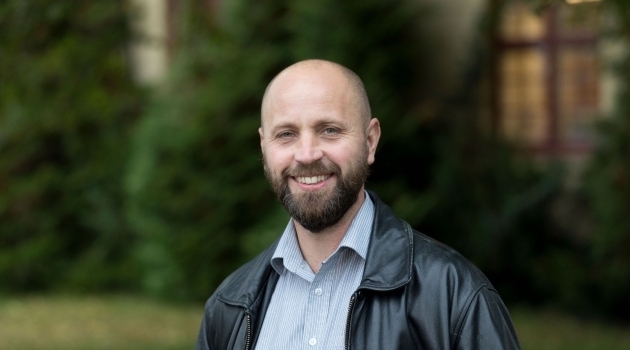Hjärnäpple winner: “Believing is a must”
“Hello, Håkan Engqvist, Professor of Applied Materials Science and recipient of this year’s Hjärnäpple*, Uppsala University’s prize for successful knowledge transfer. You’ve been involved in starting several companies and have more than 50 patents. Have you been working on innovations for long?”
“Yes, I have – ten years. After getting my PhD I worked in industry for eight. Then I joined UU Innovation and was a co-founder of Ångström Materials Academy (ÅMA), with Lars Jonsson and Lars Erik Larsson. I started a research group, and when my professor retired I applied for his job.
“I’m a fairly strong believer in integrating the knowledge triangle – that’s how I work. ‘My’ knowledge triangle comprises research, education and innovations, but may also contain various forms of collaboration.”
“A feature your projects share is that they’re about ceramic materials used in the human body. OssDsign is used to repair skull fractures. What else is under way in your companies?”
“Emplicure was initially a collaborative research project with the Orexo company here in Uppsala. We work to safeguard against drug misuse by packaging powerful painkillers in ceramic materials. Psilox is a spinoff from Biomatcell, a VinnExcellence centre in Gothenburg where I worked as a researcher. Today, Psilox is working on toothpaste and gel to treat hypersensitive gums.
“We’re also involved in some interesting projects on the research side. For instance, we’ve developed the world’s toughest glass ceramic for artificial teeth, and are researching a glue that can be used to mend fractures,”
“You’re involved in starting companies, but you don’t get into their operations. Instead, you’re a board member. Is staying out of the business side difficult?”
“No, it works fine. You have to see your own role. Professional issues from a company perspective come up quite quickly, and I’m not good at organisational matters, while there are others who are great at them. This is what I do. The research is what keeps me busy.”
“What’s your top tip for succeeding in innovations and collaboration?”
“In every project and all research, believing in your projects is a must. If you don’t believe, you don’t get others to join you and then it’ll never work. On the other hand, if I think I’m onto something good, I just crack on with it. It doesn’t matter whether it’s a thoroughly solid idea for basic research or whether I think I can meet a particular need. But just being fired with enthusiasm isn’t enough: you have to be strategic and select what to concentrate on.”
“What help have you had from Uppsala’s innovation system?”
“Every project I’ve been involved in has gone through the innovation system in Uppsala. They’ve helped with everything from seed money to legal issues. We’ve had a tremendous lot of IP and patent advice, and a bit of business development. It can be hard for companies to get through the first stage, but it’s an everyday matter for UU Innovation and UUAB. They’ve got a good grasp of all that. You need to have a sound project, good people and early investors. Only then do you have a sporting chance of establishing a business.”
Facts
Every year, Uppsala University awards the ‘Hjärnäpple’ Innovation Prize to one or more researchers or doctoral students for transferring knowledge from academia to a business and/or other organisation. The transfer must have been outstanding and resulted in an innovation. The Prize, consisting of a diploma, sculpture and scholarship for SEK 50,000 kronor, is awarded in conjunction with the Inauguration of Professors ceremony.
*) The Swedish word hjärnäpple, literally ‘brain apple’, is a pun, or play on words. The first half of the word sounds like järn (iron), and is an oblique reference to the ‘iron apple’ sculpture bestowed on the winner along with the prize money. See www.uu.se/en/about-uu/traditions/prizes/hjarnapplet.
Annica Hulth

